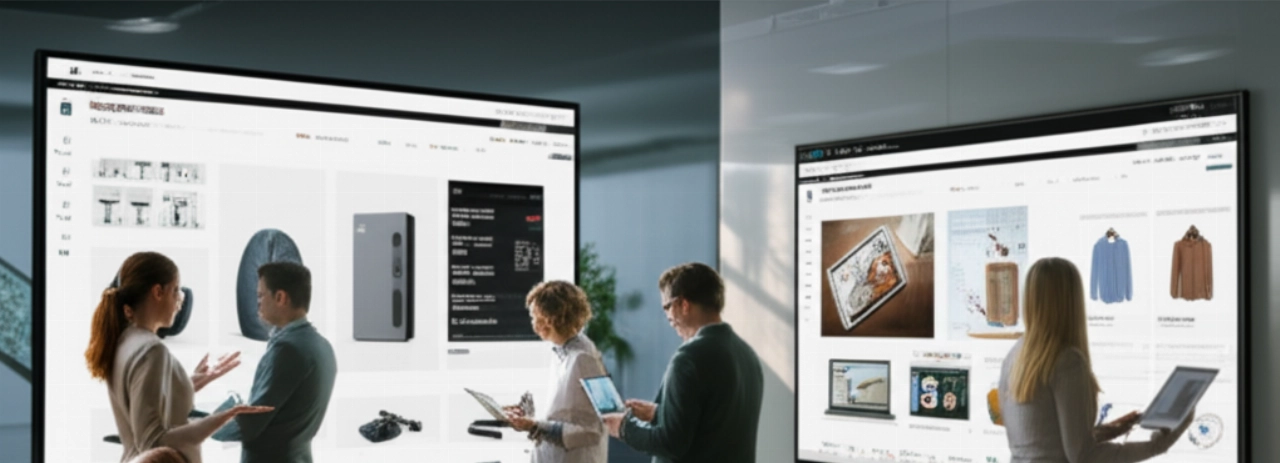In the complex landscape of enterprise e-commerce, the true battle isn't just for market share; it's for customer share. Yet, for many B2B and enterprise organizations, customer data remains fragmented, trapped in silos across disparate systems. Your e-commerce platform knows what they bought, your ERP knows what they paid, and your CRM holds their service history – but who truly knows your customer?
This disconnected reality leads to more than just operational headaches; it strangles growth, stifles personalization, and inflates your Total Cost of Ownership (TCO). The promise of a CRM integration for ecommerce isn't merely about syncing data; it's about engineering a single source of truth for your customer, transforming raw information into actionable intelligence that drives sales, loyalty, and unparalleled operational efficiency.
This article is your definitive roadmap to achieving that unified customer view, moving beyond mere transactions to build enduring, profitable relationships.

Beyond the Transaction: How CRM Integration for Ecommerce Fuels Your Growth Engine
Imagine a world where every customer interaction, every purchase, every service request, and every marketing touchpoint contributes to a single, comprehensive unified customer profile. This isn't a futuristic dream; it's the immediate, tangible benefit of a strategically executed CRM integration for ecommerce.
This integration transforms your e-commerce platform from a mere sales channel into a powerful data collection engine, feeding rich insights directly into your CRM. The result? You gain the ability to:
- Personalize at Scale: Deliver highly relevant product recommendations, tailored promotions, and personalized content based on purchase history, browsing behavior, and service interactions. This isn't just about 'nice-to-have' features; it's about driving higher conversion rates and increasing customer lifetime value (CLV).
- Optimize Sales & Service Workflows: Empower your sales team with real-time insights into customer activity, enabling proactive outreach and more effective cross-selling or up-selling. Customer service agents gain immediate access to order history, support tickets, and communication logs, leading to faster resolution times and improved satisfaction.
- Enhance Marketing Automation: Segment your audience with precision, launch targeted campaigns, and nurture leads more effectively by leveraging a complete view of customer journeys. Integrate with your marketing automation platform to create seamless, multi-channel experiences.
- Improve Forecasting & Strategy: With a holistic view of customer data, you can identify trends, predict future demand, and make data-driven decisions that impact product development, inventory management, and overall business strategy.
This is the strategic advantage that separates market leaders from those struggling with fragmented data: the ability to understand, anticipate, and serve your customers with unparalleled precision.

The Hidden Costs of Disconnected Data: Why Your CRM Integration Needs a Strategic Approach
The allure of quick fixes or 'off-the-shelf' connectors for your CRM integration for ecommerce can be tempting. However, without a strategic, enterprise-grade approach, these seemingly simple solutions often lead to a new set of problems, creating what we call 'data silos' and operational nightmares.
Consider the true costs of a poorly planned or incomplete integration:
- Manual Data Entry & Errors: Your teams spend countless hours manually transferring data between systems, leading to inevitable human errors, inconsistencies, and a significant drain on productivity. This isn't just inefficient; it's a direct hit to your bottom line.
- Inconsistent Customer Experience: A customer calls support, and the agent has no visibility into their recent online order. A sales rep pitches a product the customer already purchased. These disjointed experiences erode trust and drive customers to competitors.
- Missed Sales & Marketing Opportunities: Without a unified view, your marketing efforts are generic, your sales team lacks critical context, and opportunities for personalized upsells or cross-sells are simply missed. You're leaving revenue on the table.
- Scalability Ceiling: As your business grows, so does your data. A brittle, non-scalable integration will buckle under increased traffic and transaction volume, leading to performance bottlenecks and system failures.
- Compliance Risks: Fragmented customer data makes it exponentially harder to ensure compliance with data privacy regulations (e.g., GDPR, CCPA), increasing your exposure to hefty fines and reputational damage.
These aren't just technical glitches; they are fundamental inhibitors to growth, creating a technical debt that accrues interest over time. A strategic approach to CRM integration for ecommerce is not an expense; it's an essential investment to avoid these debilitating hidden costs.

Building Your Unified Customer Hub: Key Pillars of a Successful CRM Integration Strategy
Achieving a seamless, high-ROI CRM integration for ecommerce requires more than just connecting two systems. It demands a meticulous blueprint, a deep understanding of your business processes, and an API-first mindset. Here are the critical pillars we focus on:
- Comprehensive Data Mapping & Governance: Before a single line of code is written, we meticulously map out every data point – from customer profiles and order history to product preferences and service interactions. This ensures data consistency, accuracy, and defines how information flows between your e-commerce platform, CRM (e.g., Salesforce, HubSpot, Microsoft Dynamics 365), ERP, and PIM systems.
- Robust API-First Architecture: We advocate for an API-first approach, building flexible, scalable integrations that allow systems to communicate seamlessly and in real-time. This ensures your integration isn't a rigid, one-time connection but a dynamic, evolving data highway capable of handling future needs and new system additions. This aligns perfectly with a composable commerce strategy.
- Automated Workflows & Business Logic: Beyond data sync, a successful integration automates critical business processes. This includes automated lead creation in CRM from e-commerce sign-ups, real-time order status updates, synchronized customer segmentation for marketing, and automated service ticket generation.
- Scalability & Performance Optimization: Enterprise-level commerce demands an integration that can handle high volumes of data and transactions without impacting site performance. We design solutions that are not only robust but also optimized for speed and future growth, preventing the performance bottleneck that can kill conversions.
- Security & Compliance: Handling sensitive customer data requires the highest level of security. Our integration strategies prioritize data encryption, access controls, and adherence to industry best practices and regulatory requirements, safeguarding your business and your customers.
This structured approach ensures your CRM integration for ecommerce isn't just a technical project, but a strategic initiative that delivers measurable business outcomes.
From Data Chaos to Strategic Advantage: Partnering with Commerce K for Seamless CRM Integration
The difference between a vendor and a partner in enterprise e-commerce is profound. A vendor sells you a solution; a partner helps you define the problem, engineer the optimal solution, and navigate the complexities of implementation, ensuring your investment yields maximum ROI.
At Commerce K, we don't just connect systems; we architect a unified intelligence layer that transforms your customer data into your most powerful asset. Our expertise in complex B2B and enterprise environments means we understand the nuances of:
- Complex B2B Workflows: From tiered pricing and custom catalogs to account-based purchasing and approval flows, we integrate CRM to support your unique B2B processes.
- Legacy System Integration: We specialize in bridging the gap between modern e-commerce platforms and your existing ERP, PIM, WMS, or other legacy systems, ensuring a smooth, data-rich ecosystem without the integration hell.
- De-risking Your Project: Our proven methodologies and experienced architects minimize the risks associated with large-scale integrations, ensuring data integrity, system stability, and business continuity.
- Future-Proofing Your Investment: We build composable, API-first integrations that are flexible enough to adapt to future technology shifts and evolving business needs, protecting you from the 'one-size-fits-all' trap.
Choosing Commerce K means choosing a partner committed to unlocking the full potential of your customer data, turning it into a competitive moat that drives sustained growth and profitability.
Frequently Asked Questions about CRM Integration for Ecommerce
What is the ROI of a robust CRM integration for ecommerce?
The ROI of a strategic CRM integration is significant and multi-faceted. It includes increased sales through personalization and targeted marketing, improved customer retention and loyalty, reduced operational costs due to automation and reduced manual data entry, faster customer service resolution times, and enhanced data-driven decision-making, all contributing to a lower Total Cost of Ownership (TCO).
How complex is CRM integration for enterprise-level ecommerce?
For enterprise-level organizations, CRM integration can be highly complex due to the volume of data, the number of existing systems (ERP, PIM, WMS, etc.), custom business logic, and the need for real-time synchronization. It requires deep expertise in API development, data mapping, security, and understanding of complex B2B workflows. It's rarely a simple 'plug-and-play' solution.
Will CRM integration impact my site's performance or SEO?
A poorly executed CRM integration can potentially impact site performance if not designed for scalability and efficiency, leading to slow load times. However, a well-architected integration, particularly one built with an API-first approach, should not negatively impact performance. Regarding SEO, CRM integration itself doesn't directly affect rankings, but the improved customer experience, personalization, and operational efficiency it enables can indirectly contribute to better engagement metrics, which are favorable for SEO.
How long does a typical enterprise CRM integration project take?
The timeline for an enterprise CRM integration varies widely based on complexity, the number of systems involved, data volume, and specific business requirements. A foundational integration might take 3-6 months, while a comprehensive, highly customized integration involving multiple legacy systems and complex workflows could extend to 9-12 months or more. A thorough discovery and scoping phase is crucial to establish an accurate timeline.
Can you integrate with our existing legacy systems (ERP, PIM)?
Absolutely. Integrating with existing legacy systems like ERP (e.g., SAP, Oracle), PIM, and WMS is a core competency at Commerce K. We specialize in developing custom connectors and middleware solutions that bridge the gap between modern e-commerce and CRM platforms and your established back-office infrastructure, ensuring seamless data flow and operational continuity.
Your Future-Proof Commerce Engine Starts Here
The journey from fragmented customer data to unified intelligence is not just a technical upgrade; it's a strategic imperative. The era of disconnected systems and missed opportunities is over. Your business deserves a clear digital commerce roadmap that delivers measurable results, transforming every customer interaction into a growth opportunity.
Perhaps you're thinking, "This sounds expensive," or "We don't have the internal resources," or even, "Is this overkill for us?" The real cost isn't in making this investment; it's in delaying it. The cost of manual processes, lost sales, and customer churn far outweighs the investment in a truly integrated commerce ecosystem.
The first step isn't a quote; it's a no-obligation Scoping & Strategy Session with our senior architects. We'll help you map your potential, identify your unique integration challenges, and de-risk your investment. Click here, tell us about your project, and discover the opportunities you're currently missing. Start building your future-proof commerce engine today.
Now that you understand the power of unified customer data, explore how we execute a seamless ecommerce migration service or delve deeper into the benefits of headless commerce for ultimate flexibility.





